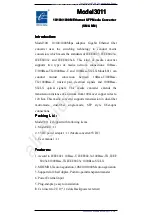
True Blue Power
®
11
Manual Number 9018067
a division of Mid-Continent Instrument Co., Inc.
Revision C, May 27, 2014
3.3.3 Example Wiring Diagrams
The inverter is flexible in the wiring installation allowing for it to be integrated into the aircraft
according to the application needs. Several examples are shown in the diagrams.
3.3.4 Harness
Verification
With the TI250 Static Inverter disconnected, activate the aircraft power bus that supplies the
unit and use a multi-meter to verify that aircraft power and ground with appropriate voltage is
on the pins within the mating harness.
3.4 MOUNTING
Refer to Section 2: Pre-Installation Considerations in regards to equipment location.
The TI250 Static Inverter is designed for base mounting only. Four ¼-20 mounting holes should be
provided in the aircraft in accordance with Figure 3.5. Secure the unit with four ¼-20 pan head phillips
screws, or equivalent. A lock washer under the head of each screw is recommended.
3.5 INSTALLATION
COMPLETION
Prior to operating the unit in the aircraft, it is recommended to verify the output and functionality of the
unit. In order to prevent accidental damage to other systems, it is best not to attach the output to other
equipment or power busses prior to verification. Verify the output of the unit at the terminating end of the
cable with a multi-meter to ensure proper voltage and polarity. Once verified, installation can be
completed and functionality of the remote on/off feature (if used) should be checked.
3.6 INSTALLATION
CAUTION
Do not connect the output of the TI250 inverter to the output of any other inverter or damage will result.
Under no circumstance allow the output of the inverter to be connected to ground utility AC power or
damage will result. If more than 250 watts of power is required for an installation, a higher power inverter
model such as the 500 watt Mid-Continent MD50 should be selected.
































